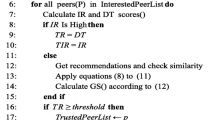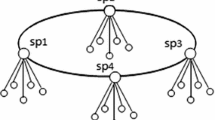Abstract
An important issue in Peer-to-Peer networks is to encourage users to share with others as they use the resources of the network. However, some nodes may only consume from users without giving anything in return. To fix this problem, we can incorporate trust management systems with network infrastructures. Current trust managements are usually made for unstructured overlays and have several shortcomings. They are made to be very similar to e-commerce scoring websites which may not be the best design for fairness in P2P networks. Several problems may arise with their designs such as difficulties to provide a complete history of freeloaders or lack of an autonomous removal mechanism in case of severe attacks. In this paper, we argue that such systems can be deployed more efficiently by using a structured paradigm. For this purpose, we propose C-Trust, a trust management system which is focused on fairness for P2P networks. This is done by getting help from current circular structured designs. This method is able to mark freeloaders, identify their severity of abusion and punish them accordingly. We are also able to effectively protect both Seeder-to-Leecher and Leecher-to-Leecher transactions. This feature is specially important for fairness which other trust systems have not considered so far.









Similar content being viewed by others
Notes
The process of routing for itself is important in fundamental design of C-Trust.
For convenience, these name are taken from Bittorrent protocol.
References
Koegel Buford JF, Yu HH, Lua EK (2009) P2P networking and applications”. Elsevier/Morgan Kaufmann, Amsterdam
Li D, Zhu Z, Cheng C, Du F (2011) TD-Trust: A Time Domain Based P2P Trust Model. Lect Notes Comput Sci 7002:467–474
Naghizadeh A, Ebrahimi Atani R Improve fairness in peer-to-peer networks by separating the role of Seeders in network infrastructures. doi:10.3906/elk-1402-304
Cover TM, Thomas JA (2006) Elements of information theory. Wiley
Jin X, Chan SG (2010) Handbook of Peer-to-Peer networking – Unstructured Peer-to-Peer network architectures. Springer, pp 117–142. doi:10.1007/978-0-387-09751-0_5
Opennap.sourceforge.net Napster protocol. http://opennap.sourceforge.net/napster.txt (2000). Accessed 14 Mar 2014
Cohen B (2003) Incentives Build Robustness in BitTorrent?presented at P2PEcon
stanford.edu The gnutella protocol specification v0.4., http://stanford.edu/class/cs244b/gnutella_protocol_0.4.pdf. Accessed 14 Mar 2014
Stoica I, Morris R, Karger D, Kaashoek MF, Balakrishnan H (2001) Chord: A scalable peer-to-peer lookup service for internet applications. vol 31(4), pp 149–160
Cordasco G, Gargano L, Negro A, Scarano V, Hammar M (2008) F-Chord: Improved uniform routing on Chord. vol 52(4), pp 325–332. doi:10.1007/978-3-540-27796-5_9
Huang H, Zheng Y, Chen H, Wang R (2010) PChord: a distributed hash table for P2P network. Frontiers of Electrical and Electronic Engineering in China 5(1):49–58. doi:10.1007/s11460-009-0068-0
Hui-Shan L, Ke X, Ming-Wei X, Yong C (2005) S-chord: Hybrid topology makes chord efficient. Springer, pp 480–487. doi:10.1007/978-3-540-31957-3_57
Hong F, Li M, Lu X, Wang Y, Yu J, Li Y (2004) VChord: Constructing Peer-to-Peer overlay network by exploiting heterogeneity. In: Embedded and Ubiquitous Computing, Wakamatsu, Japan, August 25–27. Berlin Heidelberg: Springer, pp 1096–1106. doi:10.1007/978-3-540-30121-9_105
Dellarocas C (2003) The Digitization of Word of Mouth: Promise and Challenges of Online Feedback Mechanisms. Manag Sci 49:1407142
Gross B, Acquisti A (2003) Balances of Power on eBay: Peers or Unequals. In: Workshop on Economics of Peer-to-Peer Systems
Resnick P, Zeckhauser R, Friedman E, Kuwabara K (2000) Reputation Systems: Facilitating Trust in Internet Interactions. ACM 43(12)
Aberer K, Despotovic Z (2001) Managing trust in a peer-2-peer information system. In: Proceedings of the tenth international conference on Information and knowledge management, pp 310–317, New York
Garcia-Molina H, Schlosser MT, Kamvar SD (2003) The Eigentrust algorithm for reputation management in P2P networks. In: Proceedings of the 12th international conference on World Wide Web, New York
Damiani E, di Vimercati DCC, Paraboschi S, Samarati P, Violante F (2002) A reputation based approach for choosing reliable resources in peer-to-peer networks. In: 9th ACM conference on Computer and communications security, pp 207216
Lu L, Han J, Liu Y, Hu L, Huai J, Ni LM, Ma J (2008) Zero-Knowledge Authentication in Anonymous P2Ps. IEEE Transactions on Parallel and Distributed Systems 19(10):1325–1337
Damiani E, De Capitani di Vimercati S, Paraboschi S, Samarati P (2003) Managing and Sharing Servents Reputations in P2P Systems. IEEE Trans Knowl Data Eng:840–854
Hao L, Lu S, Tang J, Zhang A (2008) A Low Cost and Reliable Anonymity Scheme in P2P Reputation Systems with Trusted Third Parties. IEEE GLOBECOM
Conti M, Salve AD, Guidi B, Pitto F (2014) Laura Ricci Trusted Dynamic Storage for Dunbar-Based P2P Online Social Networks. Lect Notes Comput Sci 8841:400–417
Tian C, Yang B (2014) A D-S evidence theory based fuzzy trust model in file-sharing P2P networks. Peer-to-Peer Networking and Applications 7(4):332–345
Menga X, Dinga Y, Gongb Y (2012) @Trust: A trust model based on feedback-arbitration in structured P2P network. Comput Commun 35(16):2044–2053
Ha B, Cho G (2013) A Collusion-Resistant Trust Management Scheme for Distributed P2P Network. Lecture Notes in Electrical Engineering 214:135–144
Xin C, Han H, Lin X (2013) Geng-yu Wei A P2P Reputation Model Based on P2P File-Sharing Behavioral Characteristics. Communications in Computer and Information Science 320:373–379
Hu Y, Wang D, Zhong H, Wu F (2014) SocialTrust: Enabling long-term social cooperation in peer-to-peer services. Peer-to-Peer Networking and Applications 7(4):525–538
Clarke S, Christianson B, Xiao H (2013) Trust*: Using Local Guarantees to Extend the Reach of Trust. Lect Notes Comput Sci 7028:171–178
Chang J, Pang Z, Xu W, Wang H, Yin G (2014) An incentive compatible reputation mechanism for P2P systems. J Supercomput 69(3):1382–1409
Kim S (2014) Repeated Public Goods Game Mode for Trust Based P2P Networks. Wirel Pers Commun 79(1):473–485
Noroozian A, de Weerdt M, Witteveen C (2013) Incentivizing Cooperation in P2P File Sharing. Lecture Notes in Computer Science 7607:36–50
Razeghi B, Okati N, Abed Hodtani G (2015) A novel approach to mathematical multiple criteria decision making methods based on information theoretic measures. In: Proceedings of the 3rd Iran Workshop on Communication and Information Theory (IWCIT), Tehran, Iran
Razeghi B, Okati N, Abed Hodtani G (2015) A novel multi-criteria relay selection scheme in cooperation communication networks,”. In: Proceedings of the 49th Annual Conference on Information Sciences and Systems (CISS), Baltimore, Maryland, USA
Hwang CL, Yoon K (1981) Multiple Attribute Decision Making: Methods and Applications, A State of the Art Survey. Sprinnger, New York
Tzeng GH, Huang JJ (2011) Multiple Attribute Decision Making: Methods and Applications. CRC Press
Vishnumurthy V, Francis P (2007) A Comparison of Structured and Unstructured P2P Approaches to Heterogeneous Random Peer Selection. USENIX Annual Technical Conference, Berkeley
Castro M, Costa M, Rowstron A (2004) Peer-to-peer overlays: structured, unstructured, or both
Montresor A, Jelasity M (2009) PeerSim: A scalable P2P simulator. In: 9th Int. Conference on Peer-to-Peer (P2P’09), Seattle, WA, pp 99–100
Author information
Authors and Affiliations
Corresponding author
Rights and permissions
About this article
Cite this article
Naghizadeh, A., Razeghi, B., Meamari, E. et al. C-trust: A trust management system to improve fairness on circular P2P networks. Peer-to-Peer Netw. Appl. 9, 1128–1144 (2016). https://doi.org/10.1007/s12083-015-0402-7
Received:
Accepted:
Published:
Issue Date:
DOI: https://doi.org/10.1007/s12083-015-0402-7




